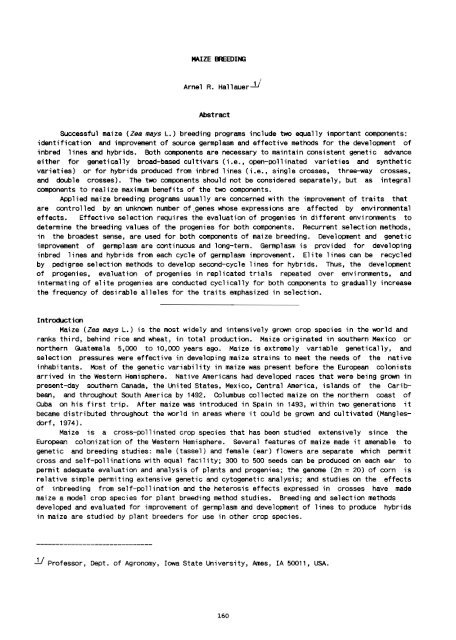Proceedings of the Fifth Asian Regional Maize Workshop - Search ...
Proceedings of the Fifth Asian Regional Maize Workshop - Search ...
Proceedings of the Fifth Asian Regional Maize Workshop - Search ...
Create successful ePaper yourself
Turn your PDF publications into a flip-book with our unique Google optimized e-Paper software.
MAIZE BREEDUG<br />
Arnel R. Hallauer-L!<br />
Abstract<br />
SUccessful maize (Zea mays L.) breeding programs include two equally important components:<br />
identification and improvement <strong>of</strong> source germplasm and effective methods for <strong>the</strong> development <strong>of</strong><br />
inbred lines and hybrids. Both components are necessary to maintain consistent genetic advance<br />
ei<strong>the</strong>r for genetically broad-based cultivars (i.e., open-pollinated varieties and syn<strong>the</strong>tic<br />
varieties) or for hybrids produced from inbred lines (i.e., single crosses, three-way crosses,<br />
and double crosses). The two components should not be considered separately, but as integral<br />
components to realize maximum benefits <strong>of</strong> <strong>the</strong> two components.<br />
Applied maize breeding programs usually are concerned with <strong>the</strong> improvement <strong>of</strong> traits that<br />
are controlled by an unknown number <strong>of</strong> ,genes whose expressions are affected by environmental<br />
effects. Effective selection requires <strong>the</strong> evaluation <strong>of</strong> progenies in different environments to<br />
determine <strong>the</strong> breeding values <strong>of</strong> <strong>the</strong> progenies for both components. Recurrent selection methods,<br />
in <strong>the</strong> broadest sense, are used for ~th components <strong>of</strong> maize breeding. Development and genetic<br />
improvement <strong>of</strong> germplasm are continuous and long-term. Germplasm is provided for developing<br />
inbred lines and hybrids from each cycle <strong>of</strong> germplasm improvement. Elite lines can be recycled<br />
by pedigree selection methods to develop second-cycle lines for hybrids. Thus, <strong>the</strong> development<br />
<strong>of</strong> progenies, evaluation <strong>of</strong> progenies in replicated trials repeated over environments, and<br />
intermating <strong>of</strong> elite progenies are conducted cyclically for both components to gradually increase<br />
<strong>the</strong> frequency <strong>of</strong> desirable alleles for <strong>the</strong> traits emphasized in selection.<br />
Introduction<br />
<strong>Maize</strong> (Zea mays L.) is <strong>the</strong> most widely and intensively grown crop species in <strong>the</strong> world and<br />
ranks third, behind rice and wheat, in total production. <strong>Maize</strong> originated in sou<strong>the</strong>rn Mexico or<br />
nor<strong>the</strong>rn Guatemala 5,000 to 10,000 years ago. <strong>Maize</strong> is extremely variable genetically, and<br />
selection pressures were effective in developing maize strains to meet <strong>the</strong> needs <strong>of</strong> <strong>the</strong> native<br />
inhabitants. Most <strong>of</strong> <strong>the</strong> genetic variability in maize was present before <strong>the</strong> European colonists<br />
arrived in <strong>the</strong> Western Hemisphere. Native Americans had developed races that were being grown in<br />
present-day sou<strong>the</strong>rn canada, <strong>the</strong> United States, Mexico, central America, islands <strong>of</strong> <strong>the</strong> Caribbean,<br />
and throughout South America by 1492. Columbus collected maize on <strong>the</strong> nor<strong>the</strong>rn coast <strong>of</strong><br />
CUba on his first trip. After maize was introduced in Spain in 1493, within two generations it<br />
became distributed throughout <strong>the</strong> world in areas where it could be grown and cultivated (Manglesdorf,1974).<br />
<strong>Maize</strong> is a cross-pollinated crop species that has been studied extensively since <strong>the</strong><br />
European colonization <strong>of</strong> <strong>the</strong> Western Hemisphere. Several features <strong>of</strong> maize made it amenable to<br />
genetic and breeding studies: male (tassel) and female (ear) flowers are separate which permit<br />
cross and self-pollinations with equal facility; 300 to 500 seeds can be produced on each ear to<br />
permit adequate evaluation and analysis <strong>of</strong> plants and progenies; <strong>the</strong> genome (2n = 20) <strong>of</strong> corn is<br />
relative simple permiting extensive genetic and cytogenetic analysis; and studies on <strong>the</strong> effects<br />
<strong>of</strong> inbreeding from self-pollination and <strong>the</strong> heterosis effects expressed in crosses have made<br />
maize a model crop species for plant breeding method studies. Breeding and selection methods<br />
developed and evaluated for improvement <strong>of</strong> germplasm and development <strong>of</strong> lines to produce hybrids<br />
in maize are studied by plant breeders for use in o<strong>the</strong>r crop species.<br />
JLI Pr<strong>of</strong>essor, Dept. <strong>of</strong> Agronomy, Iowa State University, Ames, IA 50011, USA.<br />
160

















